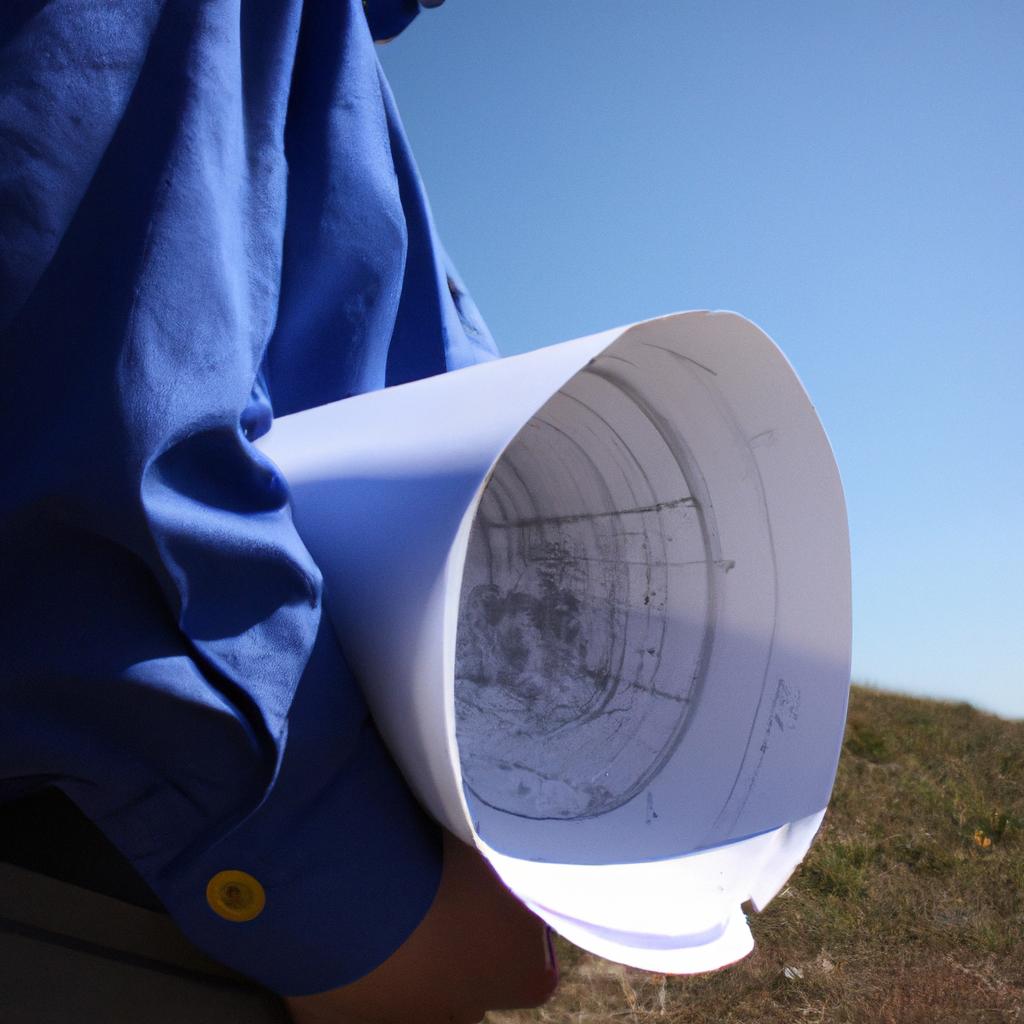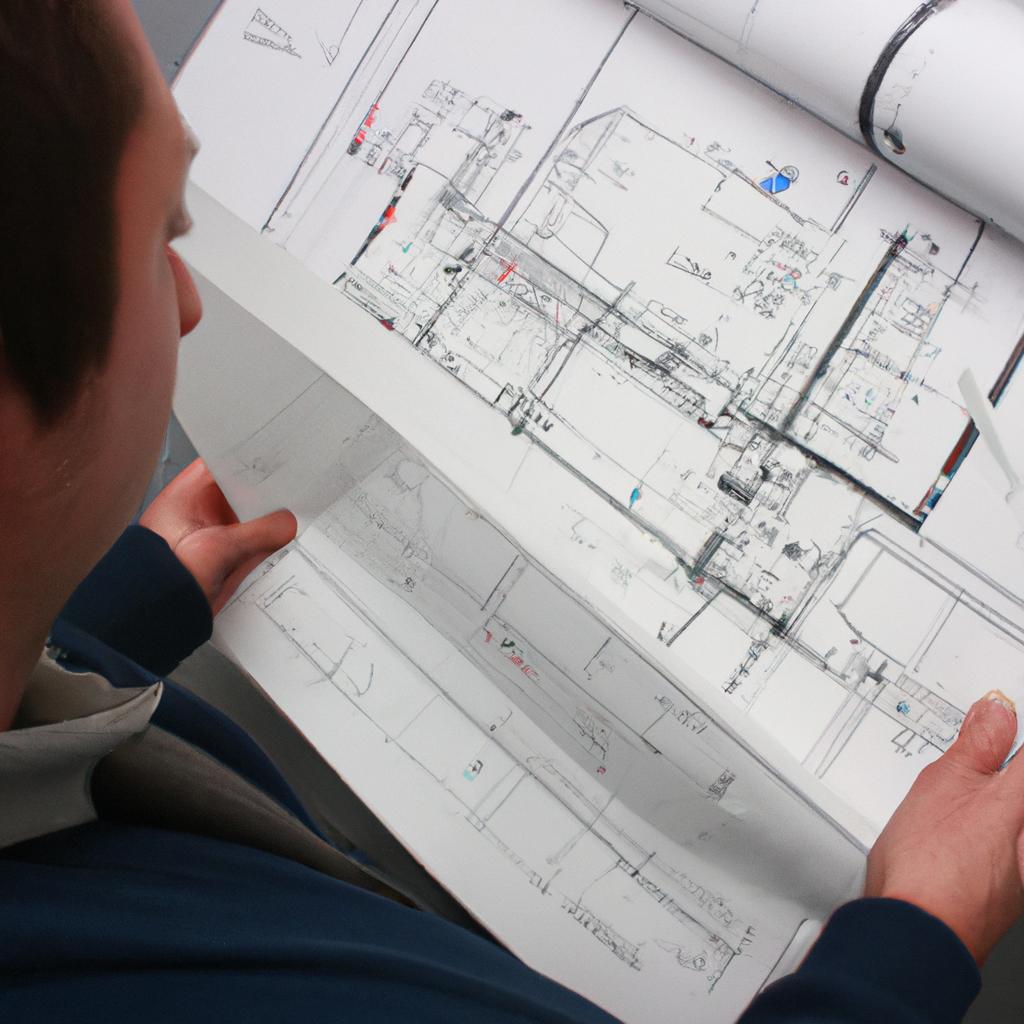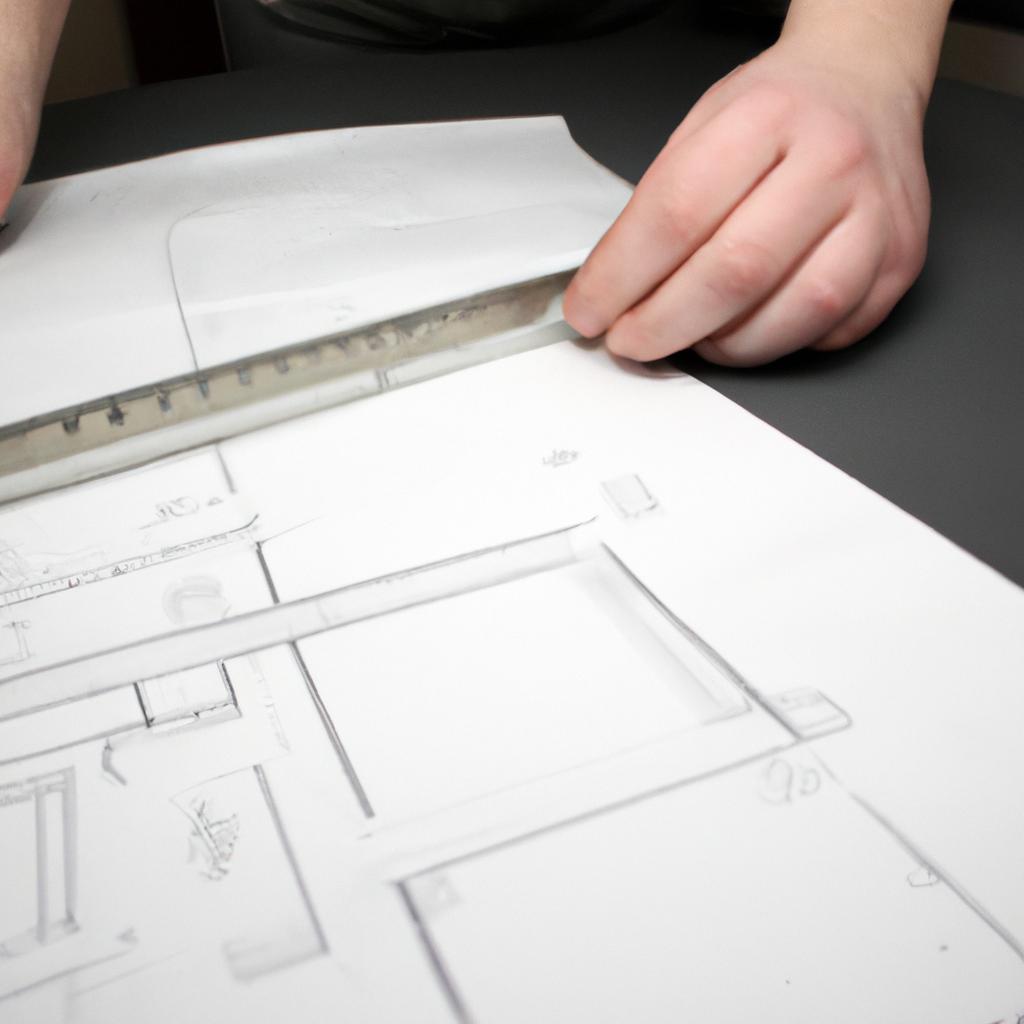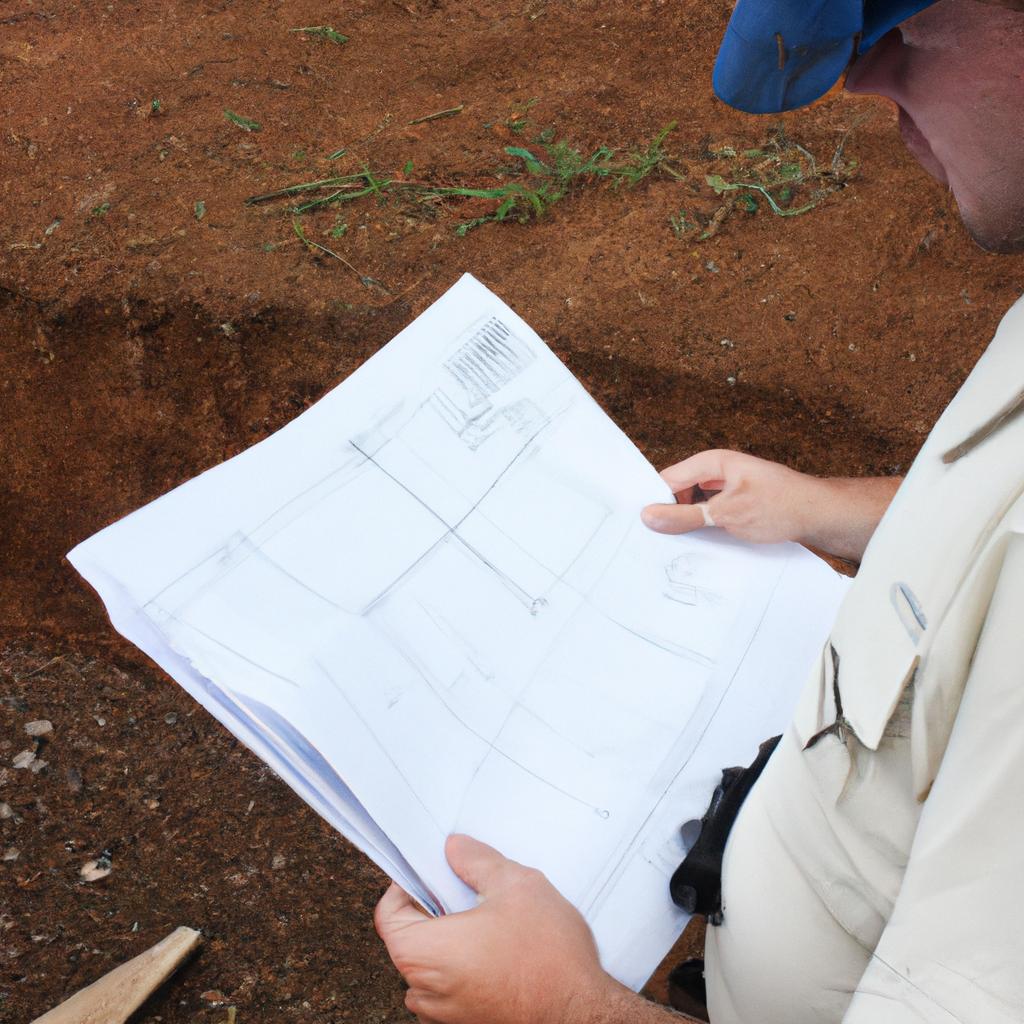Framing in construction and maintenance is a crucial aspect of any building project, serving as the structural framework that supports the entire structure. The process involves creating a skeletal frame made up of beams, columns, walls, and floors to provide stability and strength to the overall design. Blueprints play a fundamental role in guiding the framing process by providing detailed plans and specifications for constructing these essential elements.
For instance, imagine a hypothetical scenario where a team of architects is tasked with designing and constructing a multi-story office complex. They begin by meticulously drafting blueprints that outline the dimensions, materials, and connections required for each component of the frame. These blueprints act as an indispensable guide throughout the construction process, enabling builders to effectively execute their tasks while ensuring compliance with safety regulations and industry standards. Furthermore, accurate blueprint interpretation ensures alignment between architectural intent and actual implementation during framing activities.
The significance of well-constructed blueprints cannot be overstated; they serve as communication tools between various stakeholders involved in construction projects. Architects, engineers, contractors, and subcontractors rely on these documents to understand how different components fit together within the larger context of the building’s design. This article will explore the importance of blueprints in framing processes within construction and maintenance contexts, highlighting their role in ensuring structural integrity, facilitating coordination among different trades, and minimizing errors and rework.
One of the primary functions of blueprints in framing processes is to ensure structural integrity. The detailed plans and specifications provided in blueprints guide builders in accurately positioning beams, columns, walls, and floors. By following these guidelines, construction teams can create a sturdy framework that can withstand the loads and stresses placed on the building. This adherence to the blueprint’s instructions helps prevent structural failures and ensures the long-term stability of the structure.
Blueprints also play a crucial role in facilitating coordination among different trades involved in framing processes. Construction projects typically involve multiple disciplines such as carpentry, electrical work, plumbing, and HVAC systems. Blueprints provide a common reference point for all these trades to understand how their work fits into the overall framework. For example, electricians need to know where walls will be located so they can properly position electrical outlets and wiring. By providing clear instructions on dimensions and locations, blueprints help ensure seamless coordination between different trades, reducing conflicts and delays during construction.
Moreover, accurate interpretation of blueprints minimizes errors and rework during framing activities. Mistakes or misinterpretations can lead to costly revisions or even compromise the structural integrity of the building. Blueprints act as a visual representation of the design intent, allowing builders to understand spatial relationships between various components accurately. With precise measurements provided by blueprints, construction teams can minimize errors in cutting materials or positioning elements within the frame. This attention to detail reduces waste and saves both time and money.
In summary, blueprints are indispensable tools in framing processes within construction and maintenance contexts. They enable builders to construct structures with structural integrity while facilitating coordination among different trades involved in the project. Accurate interpretation of blueprints helps minimize errors and rework, ensuring efficient construction practices. Overall, blueprints serve as vital communication tools that guide construction teams towards successfully realizing architectural designs while maintaining safety and quality standards.
Definition of framing in the construction industry
Framing is an essential aspect of construction and maintenance that involves creating a structural framework to support various components of a building. It provides stability, strength, and shape to the structure while ensuring its longevity and safety. To understand framing better, let’s consider the hypothetical example of constructing a residential house.
In this scenario, framing serves as the backbone upon which all other elements are built. Typically, it starts with the creation of a sturdy foundation, followed by erecting vertical columns (studs) and horizontal beams (joists). These primary load-bearing members not only provide support but also distribute the weight evenly throughout the structure. Once these key elements are in place, additional components such as walls, roofs, floors, and windows can be installed securely.
To highlight some crucial points about framing in construction effectively, we can utilize bullet points:
- Strength: The framing system must possess sufficient strength to withstand various loads imposed on the structure over time.
- Durability: High-quality materials should be used for framing purposes to ensure long-lasting performance.
- Precision: Accurate measurements and precise assembly techniques are vital to maintain structural integrity.
- Flexibility: Framing enables adaptability during modifications or renovations without compromising overall stability.
Additionally, visual aids like tables can enhance understanding. Consider this table showcasing different types of framing techniques commonly employed in construction:
| Type | Description | Advantages |
|---|---|---|
| Platform Frame | Utilizes independent floor platforms | Cost-effective |
| Balloon Frame | Vertical studs span multiple stories | Quick installation process |
| Post-and-Beam | Horizontal beams supported by vertical posts | Allows open interior spaces |
| Timber Frame | Traditional method using wooden joinery | Aesthetic appeal |
In summary, framing plays a pivotal role in construction projects, providing the necessary support and structure for buildings. By understanding its definition and exploring various techniques, we can appreciate the fundamental importance of framing in creating safe and durable structures.
Moving forward, let’s delve into the different types of framing techniques used in construction without delay.
Types of framing techniques used in construction
Framing Techniques in Construction: Understanding Blueprints
To better understand the concept of framing in construction, let’s consider a hypothetical scenario. Imagine you are building a house from scratch. You have the architectural plans laid out before you, complete with detailed blueprints. These blueprints serve as your guide for constructing the framework or structure of the house.
When it comes to framing techniques used in construction, there are several methods employed by professionals to achieve structural stability and durability. Here are some commonly utilized approaches:
- Platform Framing: This technique involves constructing each floor level separately, starting with the foundation and proceeding upwards. It is commonly used in residential buildings where walls on one level rest directly on top of walls from the lower level.
- Balloon Framing: Traditionally used in older homes, balloon framing employs long vertical studs that span multiple floors without interruption. Although less common today due to fire safety concerns, this method can still be found in certain historical structures.
- Timber Frame Construction: Popular for its aesthetic appeal and environmental sustainability, timber frame construction utilizes large wooden beams joined together with mortise and tenon joints or other connecting mechanisms.
- Steel Frame Construction: Employed primarily in commercial buildings and high-rise structures, steel frames provide excellent strength-to-weight ratios and offer flexibility in design options.
Now let us delve into how these different framing techniques are represented within blueprints.
| Blueprint Symbols | Description |
|---|---|
 |
Represents load-bearing walls |
 |
Indicates window location |
 |
Depicts door placements |
 |
Shows stair locations if applicable |
These symbols give builders visual cues about various elements during the construction process while referring to blueprints.
Understanding accurate measurements plays a crucial role in framing, as it ensures the structural integrity and safety of the building. Inaccurate measurements can lead to misaligned walls, compromised load-bearing capacity, and potential hazards. Therefore, precise measurement techniques must be followed during the construction phase.
As we transition into the next section that discusses the importance of accurate measurements in framing, let us emphasize the significance of proper planning and execution when utilizing different framing techniques. By understanding blueprints and employing precise measurements, builders can effectively construct sturdy structures that meet architectural specifications while ensuring occupant safety.
Importance of accurate measurements in framing
Types of framing techniques used in construction play a crucial role in ensuring the structural integrity and stability of a building. Accurate measurements are essential to achieve precise and reliable results in framing. By understanding the importance of accurate measurements, constructors can avoid costly mistakes and ensure the successful completion of their projects.
For instance, let’s consider the case study of a residential house being constructed using timber frame technique. The constructor must accurately measure the dimensions of each wooden beam to be installed for supporting load-bearing walls. Even a slight miscalculation could compromise the overall strength of the structure, potentially leading to safety hazards or long-term damage.
To emphasize further on why accurate measurements are vital in framing, we can explore some key reasons:
- Safety: Precise measurements help ensure that all components fit together securely, reducing the risk of collapse or accidents.
- Efficiency: Accurate calculations enable efficient use of materials, minimizing waste and saving costs.
- Aesthetics: Properly measured frames result in well-aligned walls and surfaces, enhancing visual appeal.
- Longevity: Careful measurement ensures durable structures with reduced chances of settlement or structural issues over time.
To illustrate this concept more visually, here is an example table showcasing different types of framing techniques along with their corresponding accuracy requirements:
| Framing Technique | Accuracy Requirement |
|---|---|
| Platform Framing | High |
| Balloon Framing | Moderate |
| Timber Frame | High |
| Steel Frame | Very high |
As we can see from this table, certain framing techniques demand higher levels of precision than others. This emphasizes the significance of accurate measurements tailored to specific methods employed during construction.
In summary, accurate measurements are critical when it comes to framing in construction. They contribute not only to safety but also efficiency, aesthetics, and longevity. Constructors should prioritize meticulous planning and execution while adhering to industry standards and regulations. With this understanding of accurate measurements, we can now delve into the common materials used for framing in construction.
Common materials used for framing in construction
Importance of Accurate Measurements in Framing
Accurate measurements play a crucial role in framing, ensuring the structural integrity and overall quality of construction projects. Let’s consider an example to illustrate this point: Imagine constructing a residential building where every wall is built slightly shorter or longer than intended due to inaccurate measurements. This discrepancy could lead to uneven floors, walls that are not properly aligned, and ultimately compromise the stability of the entire structure.
To emphasize the significance of precise measurements in framing, let us explore four key reasons why accuracy matters:
-
Structural Stability: By adhering to accurate measurements during the framing process, builders can ensure that all load-bearing components are appropriately sized and positioned. This helps distribute weight evenly throughout the structure, preventing potential collapses or compromised safety.
-
Energy Efficiency: Properly measured and installed insulation plays a vital role in maintaining energy efficiency within a building. Inaccurate dimensions may result in gaps or overlaps between insulation materials, reducing their effectiveness and leading to increased heating or cooling costs for occupants.
-
Aesthetic Appeal: Precise measurements contribute to visually pleasing outcomes by ensuring straight walls, level surfaces, and well-aligned openings such as doors and windows. Accurate framing allows for smoother finishes and easier installation of other elements like flooring and cabinetry.
-
Cost-Effectiveness: Inaccurate measurements often lead to rework or modifications during construction, resulting in additional expenses for both labor and materials. By getting it right from the start, builders can save time, resources, and minimize costly errors.
Table: Common Tools Used for Accurate Measurement in Framing
| Tool | Purpose | Example |
|---|---|---|
| Tape Measure | Measuring lengths | 25 ft |
| Level | Determining horizontal/vertical alignment | 48 in |
| Speed Square | Marking angles | 7″ |
| Laser Level | Ensuring precise leveling and alignment | – |
In summary, accurate measurements are of utmost importance in framing to ensure structural stability, energy efficiency, aesthetic appeal, and cost-effectiveness. By employing the right tools and techniques for measuring, builders can avoid potential issues that may arise from inaccuracies. The next section will delve into the challenges and considerations faced in framing maintenance.
Transitioning seamlessly into the subsequent section about “Challenges and Considerations in Framing Maintenance,” it is crucial to address various factors that need careful attention while maintaining framed structures.
Challenges and considerations in framing maintenance
In the world of construction, framing plays a crucial role in providing structural support and stability to buildings. However, like any other aspect of construction, framing also requires regular maintenance to ensure longevity and safety. This section will explore some of the challenges and considerations involved in framing maintenance.
To better understand these challenges, let’s consider an example scenario where a residential building experiences significant water damage due to a leaking roof. The damage has not only affected the interior finishes but has also compromised the framing structure itself. In such cases, addressing the following factors becomes essential:
-
Inspection and Assessment: A thorough inspection is necessary to identify the extent of damage caused by water or any other external factor. It involves evaluating both visible signs (e.g., cracks) and hidden issues (e.g., rotting wood). An accurate assessment allows for appropriate decision-making regarding repairs or replacements.
-
Materials Selection: When it comes to maintaining or repairing frames, selecting suitable materials is paramount. Factors such as durability, compatibility with existing structures, resistance to environmental conditions, and cost-effectiveness must be carefully considered. For instance, using treated lumber can help prevent future decay caused by moisture exposure.
-
Quality Workmanship: Proper installation techniques are critical for ensuring long-lasting results in framing maintenance. Employing skilled professionals who adhere to industry standards can significantly reduce the likelihood of future issues arising from inadequate workmanship.
-
Ongoing Maintenance Plan: Implementing an effective maintenance plan helps minimize potential problems down the line. Regular inspections, timely repairs when needed, and preventive measures can extend the lifespan of framed structures while reducing costly damages over time.
Emphasizing these considerations sets a solid foundation for successful framing maintenance projects that promote safety and sustainability within built environments.
Moving forward into our next section on “Key factors to consider when selecting a framing contractor,” it is important to recognize the crucial role that experienced professionals play in ensuring the success of framing projects. By selecting a reputable contractor, individuals and organizations can further optimize their construction or maintenance endeavors.
Key factors to consider when selecting a framing contractor
Having explored the importance of framing maintenance, it is now imperative to delve into the various challenges and considerations that arise when dealing with such tasks. By understanding these factors, both construction professionals and homeowners can make informed decisions regarding their framing maintenance needs.
Case Study: Let us consider a hypothetical scenario where a homeowner notices cracks forming on the walls of their recently constructed house. Upon closer inspection, they discover that the issue stems from inadequate framing during construction. This case study highlights one of the many challenges that can surface in framing maintenance, emphasizing the significance of addressing them promptly.
-
Structural Integrity: One crucial aspect to consider when maintaining framing structures is ensuring their structural integrity remains intact. Poorly executed framing techniques or unaddressed issues like rotting wood or insect infestations may compromise this integrity over time. Regular inspections are thus necessary to identify any potential weaknesses before they escalate into more significant problems.
-
Moisture Management: Another challenge faced in framing maintenance relates to moisture management. Excessive moisture accumulation within wall cavities or around wooden frames can lead to mold growth and decay, compromising both aesthetics and functionality. Implementing proper waterproofing measures during construction and regularly monitoring moisture levels are essential for mitigating these risks.
-
Sustainability Practices: In today’s environmentally conscious world, incorporating sustainable practices has become paramount in all aspects of construction and maintenance. When it comes to framing, utilizing responsibly sourced materials like certified wood products helps reduce deforestation while promoting eco-friendly alternatives.
-
Cost Considerations: Finally, cost considerations play a vital role in framing maintenance decision-making processes. While regular inspections and preventive measures may require an upfront investment, addressing any underlying issues promptly can save significant expenses down the line by preventing further damage or costly repairs.
Table example (markdown format):
| Challenge | Importance | Solution |
|---|---|---|
| Structural Integrity | Ensures safety and stability | Regular inspections and prompt repairs |
| Moisture Management | Prevents mold growth and wood decay | Proper waterproofing measures |
| Sustainability | Promotes eco-friendly practices | Utilizing certified wood products |
| Cost Considerations | Minimizes long-term expenses | Addressing issues promptly |
In conclusion, framing maintenance presents various challenges that require careful consideration. By prioritizing structural integrity, managing moisture effectively, embracing sustainable practices, and considering cost implications, homeowners and construction professionals can ensure the longevity and functionality of their framing structures.
 Location Benne Gironde
Location Benne Gironde



